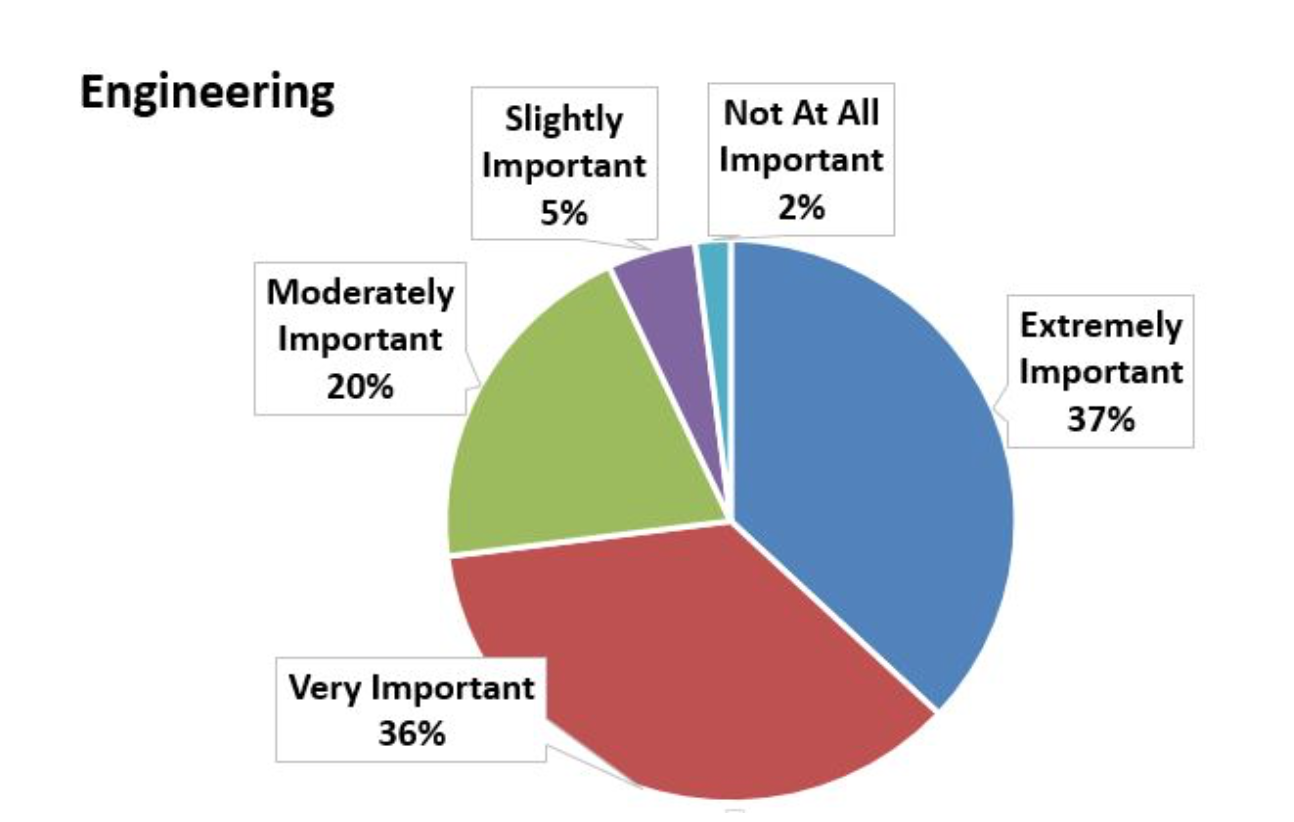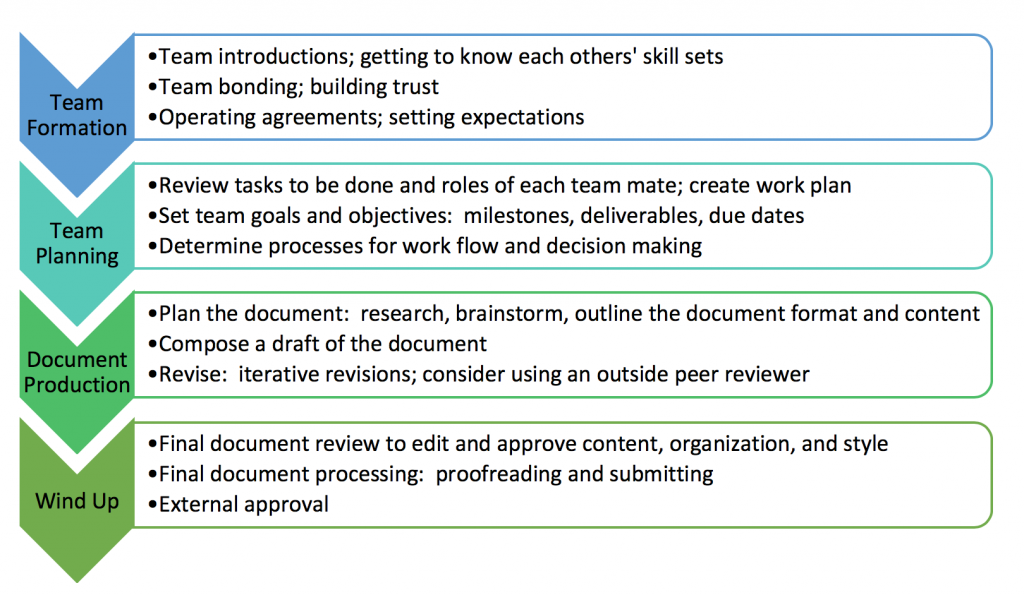Suzan Last and Candice Neveu
You have likely had at least one opportunity to work and write collaboratively with others, as this is an increasingly common way to work, both in school and in the workplace. The engineering design process, at least in part, entails working collaboratively to gather, organize, manage and disseminate information.[1] This information is often carefully analyzed and used to make important decisions, so it is critical that team members collaborate effectively in managing these communications tasks.
Engineers report spending a considerable amount of their time writing, and they frequently engage in collaborative writing (CW). A recent survey asked various professionals what portion of their work week was devoted to writing, collaborative writing, and international communications.[2] The results shown in Table 4.3.1 indicate that collaborative writing makes up a significant portion of overall writing tasks.
| Engineers | Programmers | |
|---|---|---|
| Time spent writing | 35 | 25 |
| Time spent planning and writing documents collaboratively | 19 | 12 |
| Time spent communicating internationally (across national borders) | 14 | 18 |
Research has also shown that “writing in general and CW in particular have been recognized to be fundamental to most professional and academic practices in engineering.”[3] Figure 4.3.1 shows that engineers rate writing skills as extremely important to career advancement.[4]

Like any kind of teamwork, collaborative writing requires the entire team to be focused on a common objective; according to Lowry et al., an effective team “negotiates, coordinates, and communicates during the creation of a common document.”[6] The collaborative writing process, like the Tuckman team formation model, is iterative and social, meaning the team works together and moves back and forth throughout the process.
Successful collaborative writing is made easier when you understand the different strategies you can apply, how best to control the document, and the different roles people can assume. Figure 4.3.2 outlines the various activities involved at various stages of the collaborating writing process.

Collaborative writing strategies are methods a team uses to coordinate the writing of a collaborative document. There are five main strategies (see Table 4.3.2), each with their advantages and disadvantages. Can you think of any other benefits or limitations?
| [Skip Table] |
|||
| Writing Strategy |
When to Use | Pros | Cons |
|---|---|---|---|
| Single-author
One member writes for the entire group |
For simple tasks; when little buy-in is needed; for small groups |
Efficient; consistent style |
May not clearly represent group’s intentions; less consensus produced |
| Sequential
Each member is in charge of writing a specific part and write in sequence |
For asynchronous work with poor coordination; when it’s hard to meet often; for straightforward writing tasks; small groups |
Easy to organize; simplifies planning |
Can lose sense of group; subsequent writers may invalidate previous work; lack of consensus; version control issues |
| Parallel Writing: Horizontal Division
Members are in charge of writing a specific part but write in parallel. Segments are distributed randomly. |
When high volume of rapid output is needed; when software can support this strategy; for easily segmented, mildly complex writing tasks; for groups with good structure and coordination; small to large groups |
Efficient; high volume of output |
Redundant work can be produced; writers can be blind to each other’s work; stylistic differences; doesn’t recognize individual talents well |
| Parallel Writing: Stratified Division
Members are in charge of writing a specific part but write in parallel. Segments are distributed based on talents or skills. |
For high volume rapid output; with supporting software; for complicated, difficult to segment tasks; when people have different talents/skills; for groups with good structure and coordination; small to large groups |
Efficient; high volume of quality output; better use of individual talent |
Redundant work can be produced; writers can be blind to each other’s work; stylistic differences; potential information overload |
| Reactive Writing
Members create a document in real time, while others review, react, and adjust to each other’s changes and addition without much pre-planning or explicit coordination |
Small groups; high levels of creativity; high levels of consensus on process and content |
Can build creativity and consensus |
Very hard to coordinate; version control issues |
Document management reflects the approaches used to maintain version control of the document and describes who is responsible for it. Four main control modes are listed in Table 4.3.3, along with their pros and cons. Can you think of any more, based on your experience?
| Mode | Description | Pros | Cons |
|---|---|---|---|
| Centralized | When one person controls the document throughout the process. | Can be useful for maintaining group focus and when working toward a strict deadline | Non-controlling members may feel a lack of ownership or control of what goes into the document |
| Relay | When one person at a time is in charge but the control changes in the group | Democratic | Less efficient |
| Independent | When person maintains control of his/her assigned portion | Useful for remote teams working on distinct parts | Often requires an editor to pull it together; can reflect a group that lacks agreement. |
| Shared | When everyone has simultaneous and equal privileges | Can be highly effective; non-threatening; good for groups working F2F, who meet frequently, who have high levels of trust | Can lead to conflict, especially in remote or less functional groups |
Roles refer to the different hats participants might wear, depending on the activity. Table 4.3.4 describes several roles within a collaborative writing team. Which role(s) have you had in a group project? Are there ones you always seem to do? Ones that you prefer, dislike, or would like to try?
| Role | Description |
|---|---|
| Writer | A person who is responsible for writing a portion of the content |
| Consultant | A person who is external to the project and has no ownership or responsibility for producing content but who offers content and process-related feedback (peer reviewers outside the team; instructor) |
| Editor | A person who is responsible for the overall content production of the writers, and can make both style and content changes; typically has ownership of the content production |
| Reviewer | A person, internal or external, who provides specific content feedback but is not responsible for making changes |
| Team Leader | A person who is part of the team and may fully participate in authoring and reviewing the content, but who also leads the team through the processes, planning, rewarding, and motivating. |
| Facilitator | A person external to the team who leads the team through processes but doesn’t give content related feedback. |
EXERCISE 4.3 Follow up and reflect
Refer back to the warm-up at the start of this section. Using the tables above, analyze your example to determine the writing strategy and mode that best describes your experience, and what role(s) you took on.
How effective was the strategy that you used? Would another strategy have been more effective?
Image Description
Figure 4.3.2 image description:
Four stages of collaborative writing
- Team Formation
- Team introductions, getting to know each others’ skill sets
- Team bonding, building trust
- Operating agreements, setting expectations
- Team Planning
- Review tasks to be done and roles of each teammate, create a work plan
- Set team goals and objectives: milestones, deliverables, due dates
- Determine processes for workflow and decision making
- Document Production
- Plan the document: research, brainstorm, outline the document format and content
- Compose a draft of the document
- Revise: iterative revisions, consider using an outside peer reviewer
- Wind Up
- Final document review to edit and approve content, organization, and style
- Final document processing (proofreading and submitting)
- External approval
- S. McCahan, P. Anderson, M. Kortschot, P. E. Weiss, and K. A. Woodhouse, “Introduction to teamwork,” in Designing Engineers: An Introductory Text, Hoboken, NY: Wiley, 2015, p. 14. ↵
- J. Swartz, S. Pigg, J. Larsen, J. Helo Gonzalez, R. De Haas, and E. Wagner, "Communication in the Workplace: What can NC State students expect?" Report from the Professional Writing Program, North Carolina State University, 2018. ↵
- J. Gimenez and J. Thondhlana, “Collaborative writing in Engineering: Perspectives from research and implications for undergraduate education,” European Journal of Engineering Education, vol. 37, no. 5, 2012, 471-487. DOI: http://dx.doi.org/10.1080/03043797.2012.714356 ↵
- J. Swartz, et al. ↵
- J. Swartz, et al. CC-BY 4.0. ↵
- P.B. Lowry, A. Curtis, and M.R. Lowry, “Building a taxonomy and nomenclature of collaborative writing to improve interdisciplinary research and practice,” Journal of Business Communication, vol. 41, 2004, pp. 66-97. DOI: https://doi.org/10.1177/0021943603259363 ↵
- (adapted from Lowry et al. [4]) ↵

